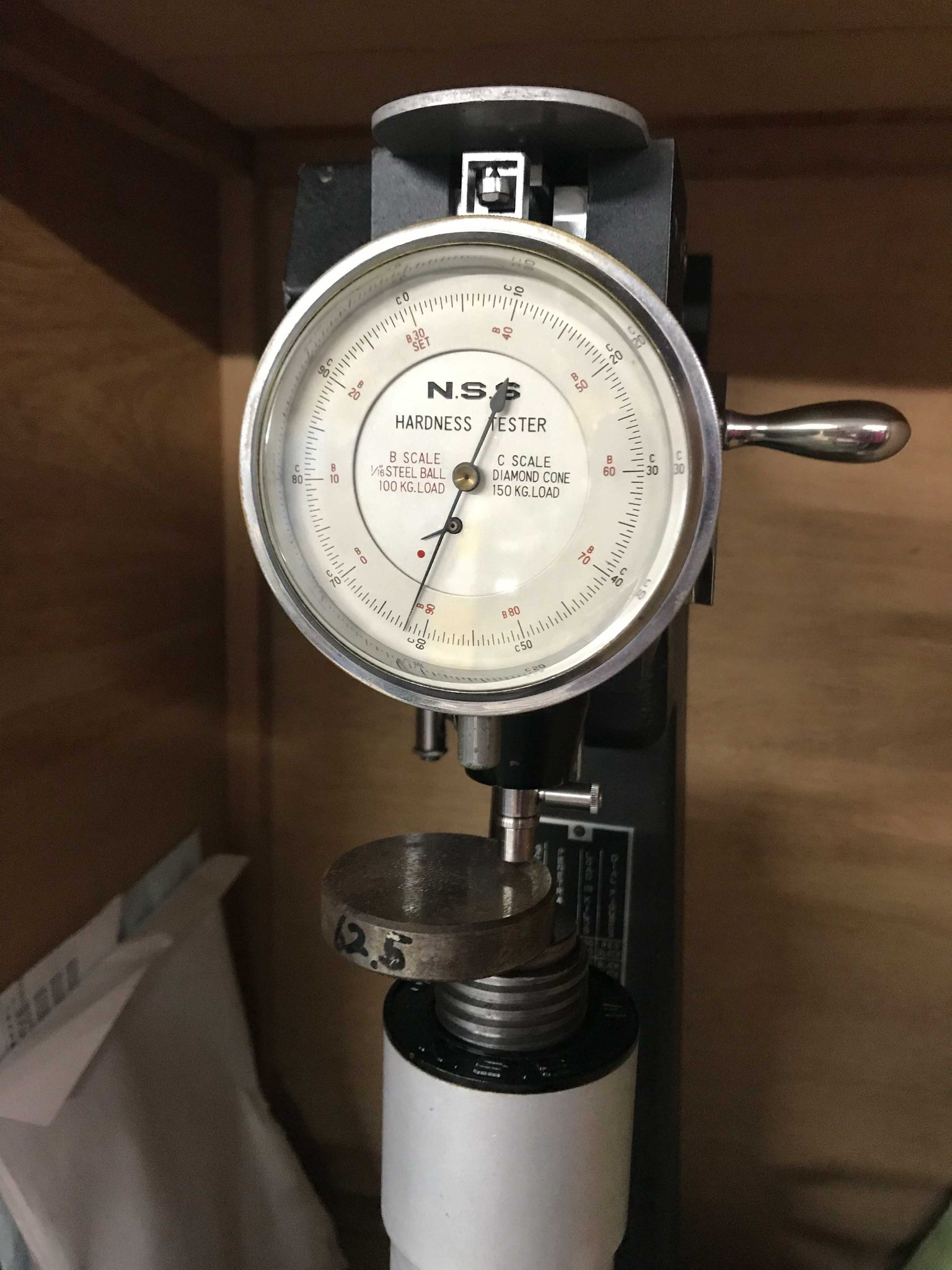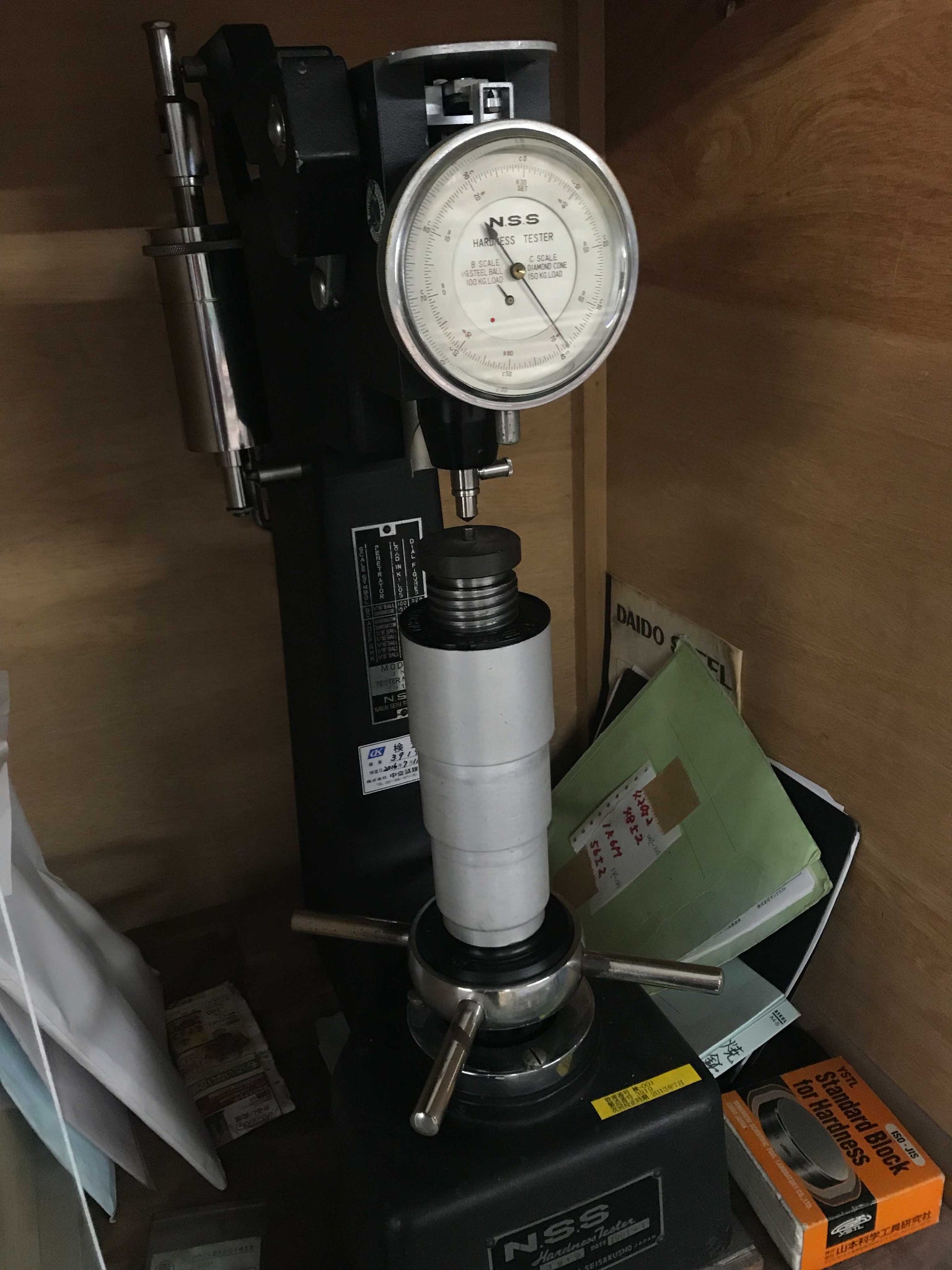When choosing the type of steel, blacksmiths consider properties such as duration of sharpness, ease of maintenance and sharpening, and, last but not least, the price and availability of steel. All these practical characteristics are inextricably linked to the hardness of steel – the main property that tool (cutlery) steels are graded against.
Hardness is by definition resistance of material to embossing or localized plastic (permanent) deformation. Consequently, it also means resistance to wear. The hardness of a metallic material depends on its chemical composition and thermo-mechanical treatment. Carbon is the chemical element that has the greatest impact on the hardness of steel, which is also positively affected by chromium, manganese, vanadium and molybdenum. Together with carbon, the latter elements form new, extremely hard compounds called carbides.
|
The connection between hardness and carbon content is clearly visible in the example below: the higher the carbon content, the higher also the HRC of various types of White Steel: |
Measuring hardness
There are several methods of measuring hardness that use their own hardness scales. Relative hardness of steel is determined according to these scales by measuring the depth of penetration of an indenter. A conical diamond is most often used and impressed on a material, then the penetration depth at standard force is measured. Different hardness scales employ their own combinations of test forces and test indentations (cone, ball etc.) and are adapted to the type of material being tested. In the cutlery industry, the most often used scale is the Rockwell scale (HRC).
➨ The hardness of solid kitchen knives starts at 56 HRC, but such blades quickly lose their edge and are harder to resharpen. However, they are more tough and ductile.
➨ The hardness of most Japanese knives is between 60 and 62 HRC, they keep an edge for a long time and are easy to resharpen due to steel structure. They are prone to breakage, however, and can get damaged if used incorrectly.
➨ Modern steels of powder metallurgy rank highest on the Rockwell scale and boast hardness around 64 and 68 HRC. These steels are rare (and hence, more expensive) and harder to process, but, when used correctly, they ensure unbelievable and long-lasting sharpness. They are also a little more sensitive and demanding to sharpen.
|
How hard is ZDP-189 steel? ZDP-189 / 66-67 HRC / C= 3 % ZDP-189 steel has an interesting chemical composition as it contains as much as 3% of carbon and 20% chromium (and other alloy elements). It is a powdered steel that can reach as high as 70 HRC if correctly heat treated, while in kitchen knives the hardness is usually around 66 and 67 HRC. ZDP-189 steel has an extremely high carbon content which is unusual for tool steels (cast iron usually has high carbon content). Due to high chromium content, ZDP-189 steel must contain such a high percentage of carbon so that the elements can transform into carbides. Carbides affect hardness and the duration of sharpness. The main advantage of this type of steel is that it retains an edge for an extremely long time. Because it’s very hard, it’s not as tough and it’s more prone to breaking. It therefore requires gentle handling on a suitable cutting surface. |
Hardness scales
➨ Hardness according to Rockwell (HRc - cone and HRb - ball)
The depth of penetration of an indenter is measured by loading a certain force. Either a ball (HRb) or cone (HRc) can be used. It is a quick and simple measurement, especially suitable for cutlery steels.
➨ Vickers hardness test (HV)
A pyramidal diamond indenter with a 136° angle is used and the force and surface of the indented pyramid is measured.
➨ Mohs scale of mineral hardness
The Mohs scale measures hardness of minerals and synthetic materials, characterizing scratch resistance of various minerals through the ability of harder material to scratch softer material. On the Mohs scale, talc has a hardness of 1 and a diamond has a hardness of 10 (according to the new scale, 15).
How is hardness measured according to HRC?
To measure hardness according to the HRC method a special device is used and it consists of three main parts: an anvil, diamond cone and a measuring dial. A sample is placed on the anvil and a minor load is applied. The measuring dial is set to zero and then a major load is applied. The depth of penetration from the zero datum is measured from a dial.
|
HRc (cone) A diamond cone with a 120° angle is impressed on the surface by applying a force of 100 N. This is the starting point for measurement. An additional force of 1400 N to 1500 N is applied and left for a “dwell time” sufficient for indentation to come to a halt. Then this load is released and the penetration depth of the cone is measured in millimeters at the initial load of 100 N. HRc hardness = 100-500h, where h equals penetration depth in mm. |
What does higher hardness value in knives mean?
✅ Higher hardness value ➨ long-lasting sharpness
✅ Higher hardness value ➨ thinner blade
❌ Higher hardness value ➨ higher brittleness
✅ For the simplest of cutting tools any steel can be used, provided that it acquired sufficient hardness in combination with toughness during heat treatment. Higher hardness value means a longer service life of the blade, because the longer a knife remains sharp (when used correctly), the less it must be sharpened.
✅ The biggest benefit of harder knives is long-lasting sharpness and a thin blade. Hardness of 60+ HRC allows a smaller sharpening angle and, consequently, less force is needed for cutting.
❌ The downside of hard knives is that they can get damaged if used incorrectly.



⬌
Unfortunately, it is impossible to combine the highest hardness values, strength and toughness, therefore knife manufacturers are trying to strike just the right balance between these properties, especially when finding the sweet spot between the duration of sharpness and brittleness.
When choosing a knife, it is therefore important to consider its purpose of use and properties, also regarding hardness. Even though HRC is indicative of the quality of material, it shouldn’t be your main guidance when choosing a kitchen knife. Different steels have their own optimal ratio ranges of properties and use, so, in addition to sharpness, you should also look at the individual properties of steel relative to what will the main purpose of your knife be.
The table below shows all the properties of cutting tools according to HRC scale 👇
|
HRC: PROPERTIES OF CUTTING TOOLS 52-54 HRC 56-58 HRC |
